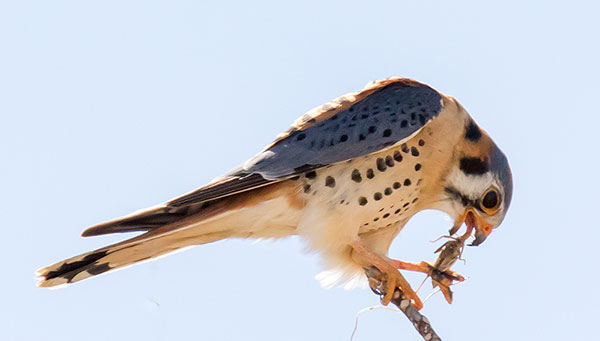Meet the American Kestrel (Falco sparverius), the smallest falcon in North America.
You can easily identify them by their slate-blue and rusty uppersides and pale undersides. These skilled predators mostly hunt by perching but you can also see them hovering over open fields.
Read on to discover more about them!
On this page
Breeding Male
Male American Kestrels have a rust-colored back and tail, slate-blue wings and head, and a pale underside.
They have two pairs of vertical stripes on their faces, black spots on their wings and back, and a black band at the tip of their tail. The black barring on their upper breast and flanks may be light or there may be none at all.
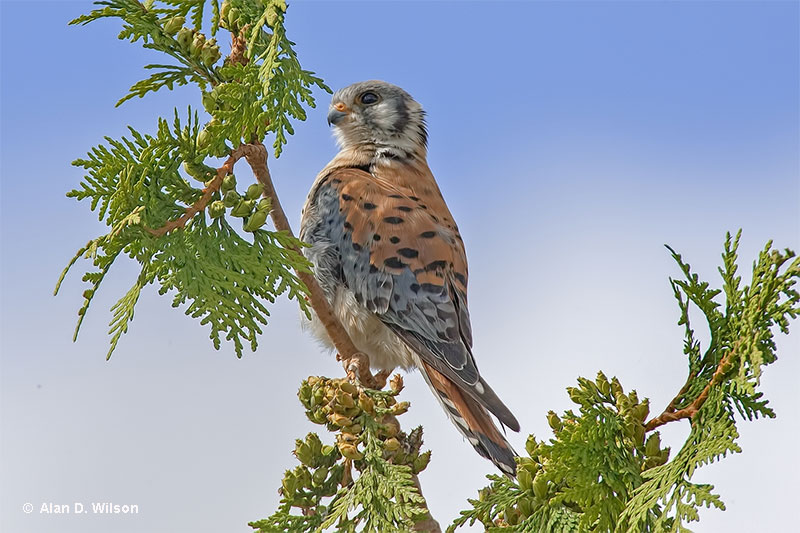
© Alan D. Wilson
Female
Female American Kestrels have similar plumage patterns but lack the slate-blue the males have.
They have warm rust-colored uppersides with black barring and pale undersides with brown streaking. Females also have reddish-brown crowns instead of grayish-blue ones and have horizontal streaks on their tails, whereas males don’t.
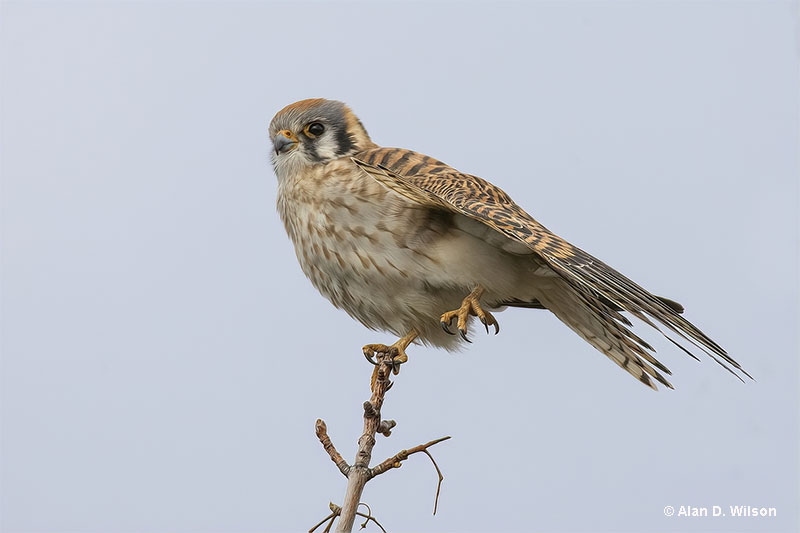
© Alan D. Wilson
Juvenile
These birds lay 2-7, most often 4-6 white to yellowish eggs that are mottled with darker colors. The eggs take 26-32 days to hatch, and the chicks stay in the nest for 28-31 days. The young depend on their parents for food and protection until about 3 weeks after fledging.
Hatchlings are covered in white down whereas juvenile American Kestrels look similar to adults.
American Kestrel’s size depends on their sex. Females grow to be about 10-15% larger than males on average. The bird can measure anywhere from 8.7-12.2 inches long and weigh between 3-6 ounces.
Habitat
American Kestrels inhabit any open or semi-open habitats that have adequate open hunting grounds, raised perches, and cavities for nesting. You can see them in various places, such as meadows and grasslands, parks and fields, cities and suburbs, and even deserts.
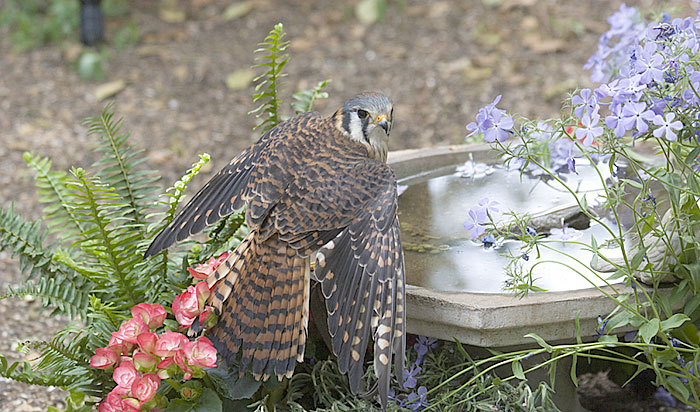
American Kestrels nest in cavities in tree hollows, rock crevices, nooks in human-built structures, old woodpecker holes and old nests, and holes in cacti.
They lack the ability to create the cavity on their own, so they must find an already existing one, preferring cavities with narrow entrances.
The female creates a shallow depression in the floor of the cavity if the material allows it, but otherwise, they don’t add anything to their nest.
Diet
American Kestrel’s diet changes depending on the season and its location. In the summer, they primarily feed on insects, such as moths, caterpillars, beetles, grasshoppers, crickets, dragonflies, scorpions, and spiders. In the winter, they focus on small mammals, birds, and other such creatures, such as mice, snakes, frogs, shrews, bats, lizards, crayfish, and songbirds.
These carnivores are active during the day and have three different hunting methods: hovering, in-flight snatching, and perch-hunting. Their primary way of hunting is perch-hunting, where they sit on taller objects in or alongside open areas. When they spot their prey, they swoop down and grab it with their talons.
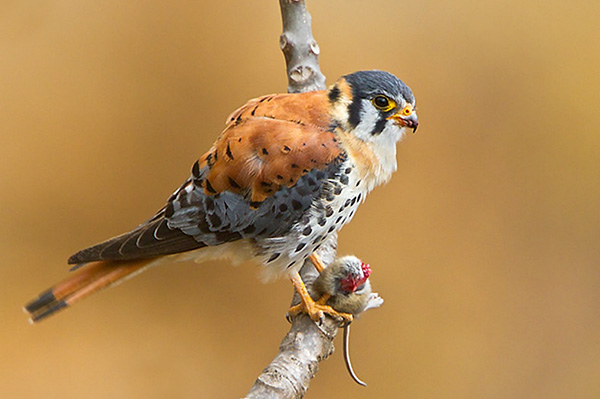
Photograph© Glenn Bartley
You might also see them hovering with rapid wingbeats and scanning the field for prey, swooping down to catch it in a similar fashion to the previous method. In-flight snatching is mostly reserved for catching insects, although they’ve been observed to strike down small songbirds this way as well.
Kestrels are intelligent hunters and will change tactics and foraging grounds if their hunting effectiveness starts to drop. Individual birds might also specialize in hunting particular prey.
Behavior
American Kestrels are solitary and only pair up during the mating season. Courtship displays involve flight displays, where the female flies slowly at a lower altitude and the male at a higher one. The male calls, dives, and gives food to the female while passing her.
During the breeding season, male kestrels are territorial and mark it by flying high into the sky, diving, and calling. The female typically broods and remains with the young whereas the male brings them food.
You can see these birds attack larger aerial predators and chase off other kestrels to defend their territory and nests. Since they’re cavity nesters, they may evict other creatures with the same ideas, such as bluebirds, squirrels, and others.
American Kestrels raised in captivity are often used in falconry. Wild specimens are held in high regard because they keep pest populations under control.
Range (and seasonal changes)
American Kestrels range throughout the Americas from Alaska to the southern tip of South America. The populations in most of the United States and South America are year-round residents and do not migrate.
However, the birds, whose breeding range extends from Alaska throughout most of Canada to eight northern U.S. states migrate to the southern United States and Central America for the winter.
These birds are one of the most common falcons in North America. They are listed as of least concern on the IUCN Red List.
Wing shape
American Kestrels have narrow and moderately long wings that recede into a point at the end. Their body and wings are made for ambushing and perch-hunting, not for long and energy-consuming flights.
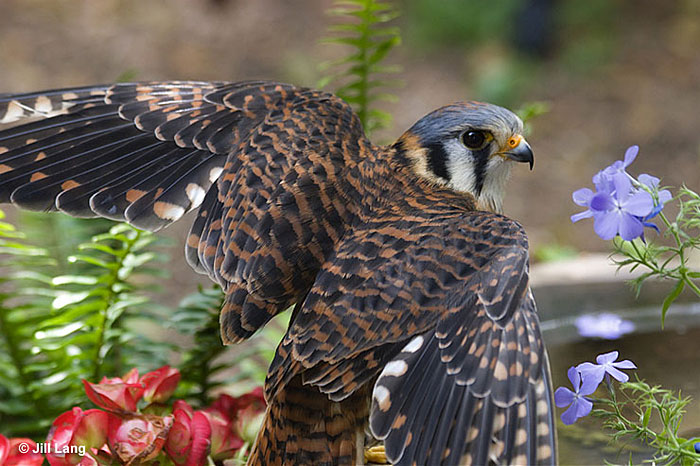
You can recognize an American Kestrel in flight by its long, pointed wings, slender body, light underside and barred wings, and quick wingbeats with short glides thrown into the mix.
Related: What do falcons symbolize?
When they’re hunting, they may sometimes hover in one place, flapping just enough to keep them steady with their head typically not moving at all.
Fun Facts
- When the breeding season ends, the male and female American Kestrels part ways and inhabit different places. Males prefer habitats with more trees, whereas females can be found in more open habitats.
- The American Kestrel has 17 subspecies which are differentiated by their range, size, plumage, and vocalizations. The southern subspecies tend to be smaller in size, whereas the northern ones are larger.
- Young American Kestrels eat around two times more than adult birds! After the offspring leave the nest, the family often hunts together as this helps the younglings practice their hunting skills before they become independent.
- American Kestrels are commonly used in falconry. This beginner-friendly bird is generally used to flush out other birds.
- American Kestrels can see UV light. This helps them to track their prey. If they manage to hunt enough so that some is left over, then the bird will cache it in tree roots, grass clumps, or cavities for later consumption.
Vocalization
American Kestrels have three basic calls that they give during courtship, feeding, or when they display excitement or stress.
The most common ones are klee or killy calls that they give 3-6 times in rapid succession. This is the easiest way to identify these birds and they give it when they’re excited or stressed.
You may hear the birds chittering during courtship, copulation, and other friendly encounters. During feeding, the birds give a long whine.
Similar Species
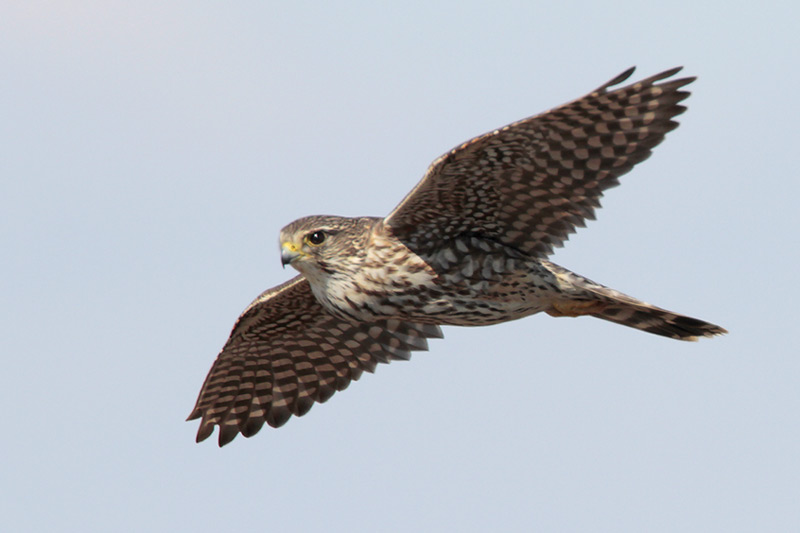
Merlin
When it comes to similarities, Merlins look the closest to American Kestrels.
Merlins are a bit bigger in size and have more grayish and raker plumage, but overall they look pretty similar. They have similar speckled patterns on their wings.
Merlins inhabit a bigger area in the United States during their non-breeding time of the year.
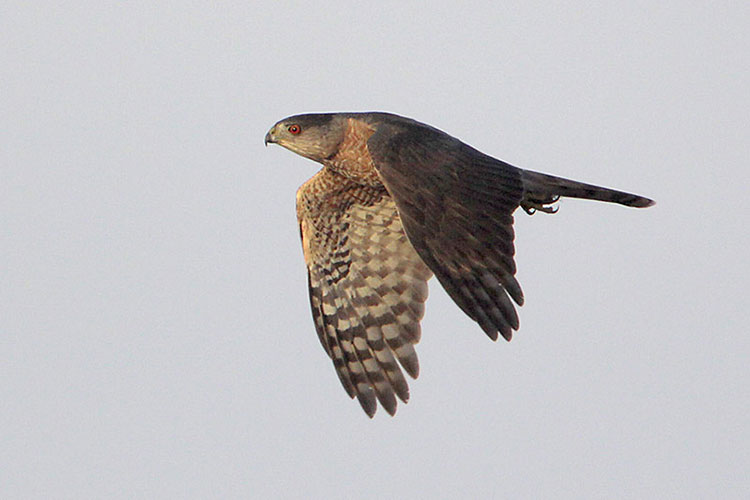
Sharp-shinned Hawk
Although Sharp-shinned Hawks are a bit bigger than American Kestrels, they look similar, especially during flight.
American Kestrels have more brown colors on their plumage (especially on the back and wigs), whereas Shapr-shinned Hawks look more gray. Sharp-shinned Hawks also have broader tails and wings.
Frequently Asked Questions
Are American Kestrels rare?
American Kestrels are the most common falcons in the United States.
What is special about kestrels?
Kestrels can hover while scanning the ground for food.
Is an American kestrel a hawk or a falcon?
American Kestrel is a falcon.
Where does the American Kestrel live?
American Kestrels range throughout the Americas from Alaska to the southernmost tip of South America. They can be found in almost all open and semi-open habitats that have open ground for hunting, tall objects for perching, and cavities for nesting.

